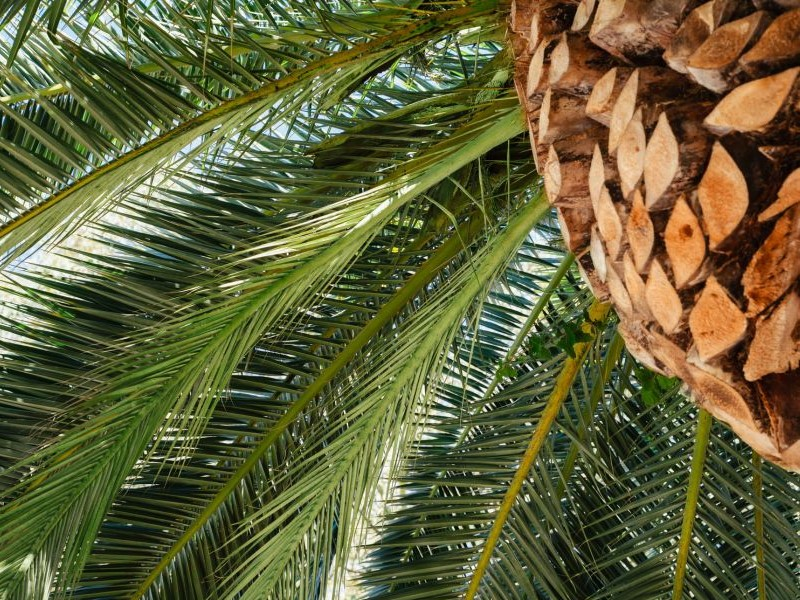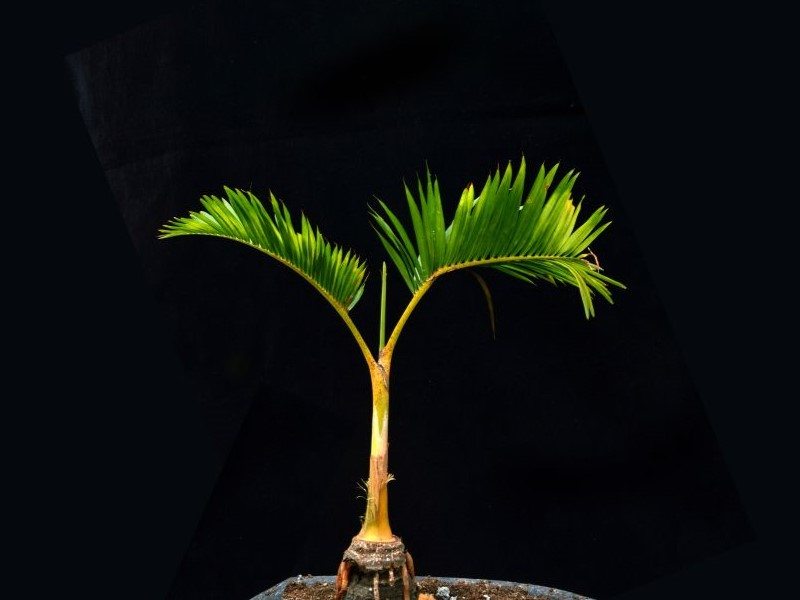Imagine those majestic palm trees swaying along the beach – now visualize that same tropical charm condensed into a tiny bonsai pot at your fingertips. More than mere trees, a bonsai palm tree is a living representation of tropical charm.
In this guide, we’ll uncover the unique features that make these bonsai trees distinctive, guiding you to cultivate your slice of paradise within the confines of your homes!
What is a Palm Tree?

A palm tree is a tropical or subtropical tree known for its distinctive appearance and widespread presence in various landscapes. These trees are recognized by their large, compound leaves, known as fronds, arranged at the top of an unbranched stem.
Scientifically classified under the family Arecaceae, palm trees encompass a diverse group of over 2,500 species. Each species has unique characteristics but commonly shares features like a tall, slender trunk and a crown of large, fan-shaped, or feather-like leaves. Palm trees thrive in warm climates and are often associated with beach landscapes but can adapt to various environments. The leaves of palm trees are evergreen, providing a continuous canopy of greenery.
Aside from their aesthetic appeal, palm trees serve various ecological purposes. They contribute to biodiversity by providing habitats for multiple organisms and play a role in stabilizing soil in coastal areas.
Popular Bonsai Palm Tree Species
Yes, you see it right. Palm trees, those iconic symbols of tropical beauty, can be cultivated as indoor bonsai trees. Now, let’s explore some popular species’ distinctive traits and appearances.
Ponytail Palm (Beaucarnea recurvata)
Distinct Traits:
- Swollen Base (Caudex): The ponytail palm, also known as bottle palm, is famous for its unique swollen base, like an elephant’s foot. This stores water, making the plant drought-tolerant and visually attractive.
- Long, Curly Leaves: With long, slender leaves having a curly texture, the ponytail palm bonsai gets its name from its distinctive “ponytail” appearance, adding charm to its overall look.
- Adaptable Indoors and Outdoors: The ponytail palms are versatile, whether outside in warm weather or as a houseplant. It does well in various light conditions, thriving indoors with bright, indirect light.
Care Requirements:
- Good Drainage Soil: Use soil drains well to avoid waterlogging and keep the roots healthy.
- Moderate Sunlight: The ponytail palm likes bright, indirect light, suitable for indoor and outdoor environments.
- Warm Environment: Originating from tropical areas, this palm prefers a warm environment. Keep it consistently warm for optimal growth, especially during colder times.
Pygmy Date Palm (Phoenix roebelenii)
Distinct Traits:
- Feather-like Fronds: The pygmy date palm is recognized for its delicate, feather-like fronds that give it an elegant and graceful appearance. These finely divided leaves mimic the structure of more enormous date palms but in a more compact form.
- Compact Size: The bonsai version of the pygmy date palm is intentionally cultivated to be smaller, making it suitable for confined spaces. Despite its reduced size, it retains the charm of a full-sized palm.
Care Requirements:
- Well-Draining Soil: Pygmy date palms thrive in soil that provides good drainage, preventing waterlogging.
- Moderate Sunlight: They prefer moderate sunlight, making them adaptable to indoor and outdoor environments.
- Warm Environment: Being tropical, they flourish in warm conditions.
Sago Palm (Cycas revoluta)
Distinct Traits:
- Symmetrical, Fern-like Leaves: The sago palm is distinguished by its balanced and arching fronds, resembling a fern. Its ornamental foliage adds a touch of ancient elegance to the bonsai collection.
- Hardiness: Sago palms are known for their resilience, making them suitable for bonsai enthusiasts of various experience levels.
Care Requirements:
- Well-Drained Soil: Like other bonsai palms, the sago palm requires soil for proper drainage.
- Indirect Sunlight: It prefers indirect sunlight, making it adaptable to different lighting conditions.
- Periodic Watering: Sago palms benefit from regular watering, allowing the soil to dry slightly between watering sessions.
Coconut Bonsai (Cocos nucifera)
Distinctive Traits:
- Iconic Fronds and Miniature Coconuts: The coconut bonsai captures the essence of the tropics with its iconic fronds and the unique addition of miniature coconuts. This distinctive feature adds an extra layer of authenticity to the bonsai experience.
- Captivating Charm: Its combination of visual appeal and the promise of tiny coconuts makes the coconut bonsai a beautiful choice.
Care Requirements:
- Well-Draining Soil: Like its counterparts, the coconut bonsai thrives in soil with good drainage.
- Ample Sunlight: It requires much sunlight to simulate its natural habitat.
- Careful Watering: To mimic its native conditions, thorough watering is essential.
Choosing and Planting a Tree
When choosing and planting this bonsai tree, it’s crucial to align the species with the specific needs of palm trees. Consider your area’s climate, focusing on temperature and sunlight requirements, to select a palm tree species that can thrive in your local conditions. For potting, opt for shallow containers with efficient drainage to prevent water stagnation, which can harm palm trees.
Additionally, ensure the soil is well-draining to balance retaining enough soil moisture and preventing root system suffocation. These tailored choices cater to the specific needs of palm trees, laying the foundation for a healthy and flourishing indoor bonsai.
Bonsai Palm Tree Care Guide
Taking care of your palm tree doesn’t have to be complicated. You can ensure your miniature tropical companion thrives and stays healthy with a few simple steps.
Sunlight and Temperature Requirements
Palm trees love sunlight but don’t crave scorching heat all day. Aim for a spot with bright, indirect sunlight. If your bonsai palm is getting too sunburned, consider providing shade during the hottest day. When it comes to temperature, most palm trees prefer a warm environment. Just avoid exposing them to frost or extreme cold temperatures.
Watering Techniques
Like any plant, palm trees need water but don’t like sitting in it. Water the soil thoroughly when the top layer feels slightly dry. Ensure good drainage in your pot, letting excess water escape. Overwatering can lead to root rot, so finding the right balance is vital. During the growing season, your palm may need more frequent watering.
Fertilization Strategies
Feeding your palm tree is like giving it a little nutritional boost. Use a balanced, slow-release fertilizer or a liquid fertilizer during the growing season, typically in spring and summer. Follow the recommended dosage on the packaging, and don’t overdo it. During the dormant season, reduce fertilizer to let your palm tree rest.
Pruning and Wiring for Aesthetic Appeal
To maintain that picturesque appearance, some occasional pruning is in order. Trim any yellow or dead fronds to encourage new growth. Wiring can help shape the trunk and branches, but do it gently to avoid damaging your palm tree. Be patient; bonsai is an art that takes time to unfold.
Troubleshooting Common Issues
Caring for your hardy plant is an art, and addressing common issues is part of the journey to keep it healthy. When dealing with pests or diseases, keen observation is crucial in identifying the problem early on. For minor pest issues, consider using natural solutions such as neem oil or gentle insecticidal soap, which are practical and less harsh on your palm. If part of your bonsai is affected, isolate it to prevent the issue from spreading.
Environmental stressors like sunburn or improper watering can impact your palm’s well-being. If you notice browning or discoloration, find a slightly shadier spot. Adjust your watering routine to avoid yellowing leaves, ensuring the soil is somewhat dry before watering. Additionally, protect your bonsai from extreme temperatures, especially cold, by relocating it to a more suitable environment.
Styling and Design Tips

When styling your palm trees, simplicity is the key to achieving an appealing and balanced design. Please focus on the unique features of palm trees to enhance their miniature representation. Carefully arrange the fronds to mimic the natural growth pattern and maintain a harmonious balance. Pay attention to the trunk structure, pruning with precision to showcase the palm’s trunk’s distinct elegance proportionately.
For bonsai palm trees, embracing an upright style is particularly effective, mirroring the characteristic growth habit of palms. This style allows the trunk to rise directly from the soil, capturing the essence of palm tree aesthetics in a compact and visually pleasing form. These uncomplicated yet practical styling tips will help you create a miniature tropical masterpiece that exudes balance and beauty.
Resources for Bonsai Tree Enthusiasts
Sourcing the right indoor plants is pivotal for acquiring a bonsai palm tree. Begin by exploring local nurseries specializing in bonsai or tropical plants, as they often carry a variety of palm species suitable for bonsai cultivation.
Garden centers may also offer these trees, particularly those focusing on tropical or exotic plants. Online platforms dedicated to bonsai sales and reputable e-commerce sites can be valuable resources for purchasing palm trees. Ensure the seller provides detailed information on the tree’s care, including its species and specific requirements.
Final Thoughts
Cultivating a bonsai palm tree is a simple yet rewarding endeavor. Please choose a suitable palm species from local nurseries or online platforms, ensuring it aligns with your climate. Explore resources, including guides and community engagement, for valuable insights.
As you shape your miniature tropical tree, savor the artistic process and the unfolding beauty. Bonsai palm trees add a touch of the tropics to your space and offer a positive, fulfilling experience. Embrace the journey, and may your bonsai palm thrive with the joy of nature’s artistry.
Happy cultivating!





0 Comments